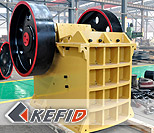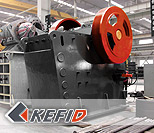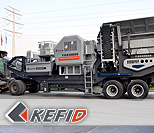Home - News Center - Product Knowledge

JAW CRUSHER SELECTION AND PERFORMANCE PRIDICTING
Jaw crushers are large, heavy-duty machines capable of crushing large quantities of tough, abrasive materials. They are typically employed as primary crushers within aggregate processing plants. Jaw crushers are most commonly defined by gape size, open and closed side sets, and capacity. There are a wide range of jaw crusher sizes for varying production and product size requirements.
The plates of a jaw crusher are used to apply compressive forces that induce tensile stresses within particles, causing fracture. Particles are repeatedly nipped until they pass through the crushing chamber. The breakage process occurring between the jaw plates acts simultaneously with a classification process. The classification process defines whether or not a particle will be subjected to crushing and is dependent upon the settings of the crusher and particle size.
The selection of a jaw crusher for application in the aggregate industry is primarily based on technical literature provided by crusher manufacturers, experience, and cost. Charts and graphs provide data on electric power requirements, crusher size (gape), as well as expected capacities for a given material and closed side set. These charts and graphs have also been incorporated into computer programs to aid in crusher selection. In order to account for material variations manufacturers rely on a suite of laboratory tests. The uniaxial compression and Bond impact crushability test are two of the most common tests used to rank materials relative to their hardness/crushability. Each of these tests has limitations and neither adequately describes a material’s resistance to fracture. Although jaw crushers are used extensively, the lack of understanding relative to their operational characteristics, as well as a reliance on an inappropriate, single set of material properties, makes selection of a proper machine difficult. Jaw crusher selection is also heavily influenced by the subjective judgment/experience of individuals, which can result in the conservative selection and operation of jaw crushers.
The prediction of crusher performance is typically concerned with the size distribution of the product exiting the crusher, the machine’s power draw, and the capacity. The capacity of a jaw crusher is dependent upon the operating characteristics of the machine and influenced by the feed size and the nature of the material. It can be determined fairly easily but there has been difficulty in accounting for the variable nature of rock materials. Bond’s theory or equation has long been used to determine the power draw and motor requirements of size reduction machines. However, its relevance to jaw crushers handling large feed sizes has been questioned. The recent trend has been to calculate power draw based on laboratory crushing tests. The modeling of crusher performance has focused mainly on the prediction of the product size distribution. The product size distribution of a crusher can be determined using the Whiten model given the feed size, the classification function, and the breakage function. The classification function is dependent upon the operating parameters of the crusher, namely the closed side and open side set. The breakage function considers breakage in terms of a series of single particle fracture events and is dependent upon the nature of the material. It is determined from a series of laboratory single particle breakage tests.
There is significant room for improvement when it comes to selecting and optimizing jaw crushers. The enhancement of crusher selection and the prediction/optimization of its performance are dependent upon the operating parameters of the machine and the physical properties of the material being broken. Early attempts at establishing relationships between these components focused on the energy consumed by a crushing machine and the resultant size reduction. Energy-size relationships themselves require an awareness of the mechanisms of fracture, the fundamentals of which are covered in the following section.
June 05, 2013
How to disconnect the jaw crusherJune 05, 2013
The Development of jaw Crushers in Modern TimesAugust 17, 2011
Characteristics of PE Jaw Crusher and JC Jaw CrushApril 10, 2011
JAW CRUSHER SELECTION AND PERFORMANCE PRIDICTINGOctober 26, 2010



